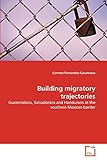Building migratory trajectories guatemalans, salvadorians and hondurans at the southern mexican border Carmen G. Fernández Casanueva
Tipo de material: Libro
impreso(a)
Idioma: Inglés Detalles de publicación: Germany VDM Verlag Dr. Müller c2010Descripción: 234 páginas ilustraciones, mapas 22 centímetrosTipo de contenido:
Libro
impreso(a)
Idioma: Inglés Detalles de publicación: Germany VDM Verlag Dr. Müller c2010Descripción: 234 páginas ilustraciones, mapas 22 centímetrosTipo de contenido: - Texto
- Computadora
- Recurso en línea
- 3639295773
- 9783639295771
- EE/304.827208 F4
Bibliografía: páginas 182-196
Acknowledgments.. Figures and Tables.. Appendices content.. Abbreviations.. Spanish Terminology.. Introduction.. Argument and aim of the study.. Contribution of the study.. Theoretical framework of the study.. Elements of analysis.. Methodology.. Organisation of chapters.. Chapter 1: The structuration process of migration is triggered off and develops: Guatemalans', Salvadorans' and Hondurans' movement to and through the Soconusco.. Background... Global, meso and microstructures initiating and developing migration in the Soconusco.. A portrait of the Soconusco, Tapachula and border towns.. Human agency: migrants crossing the Guatemalan-Chiapan border.. The Soconusco: place for heterogeneous migratory trajectories.. Shaping migratory trajectories in the Soconusco.. Mapping migratory trajectories according to occupation in the Soconusco region.. Commerce workers.. Domestic workers.. Agricultural workers.. Construction workers.. Sex and bar workers.. Service workers.. Transmigrants.. Chapter 2: Migratory trajectories: following the route from hometown to Chiapas.. Commerce sector.. Domestic sector.. Agriculture sector.. Construction sector.. Sex/bar sector.. Service sector.. Transmigrants.. Concluding... Chapter 3: Social Networks: the role of microstructures in shaping migratory trajectories from hometown to Chiapas.. Commerce workers' social network.. Domestic workers' social network.. Agricultural workers' social network.. Construction workers' social network.. Sex/bars workers' social network.. Service sector.. Transmigrants' social network.. Concluding... Chapter 4: Domestic strategies during migration trajectories.. More stable circumstances: distinctive or progressive strategies.. Less settled circumstances: Breakdown or transmigration.. Concluding.. Conclusion.. Structuration in migration studies (and in my study.. Pathway to new research.. References.. Appendices
Disponible para usuarios de ECOSUR con su clave de acceso
The book comparatively explores the process of migration after work of men and women from different Central American countries to southern Mexico. These labour migrants intend either to reach the United States in search of better material conditions or to find employment in the Soconusco region in the state of Chiapas, southern Mexico. The book examines the patterns of these migrants' interactions with each other and different situations they must cope with along their migratory trajectories from the moment they decide to migrate, through the traveling process, up to the moment they are in Mexico. Using the structuration model as a theoretical framework for analysis, it assesses the role of the structure-agency dynamic interaction in differentially shaping Central Americans' migratory trajectories. The book examines the role of surrounding economic and political circumstances, migrants' social networks, domestic (survival) strategies and gender during the migratory process. It will principally be of interest to students and scholars of Latin and Central American studies, immigration, transnationalism, border studies, global processes, and gender studies. Inglés


